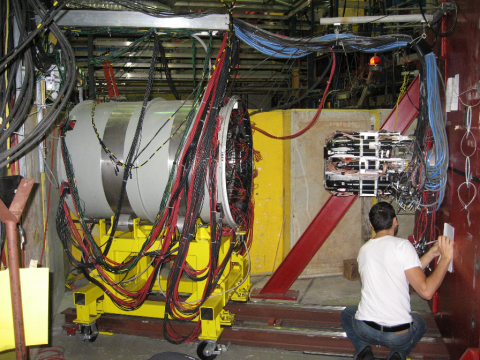
Particle physics can be seen as playing the game with much less-than-full deck of cards.
This is one of the motivations behind TRIUMF’s PIENU collaboration, a high precision measurement experiment. Inexplicable observations made in particle physics are akin to learning that you’ve misplaced the ace of spades or queen of hearts: you can still play the game, but you might not have a winning hand. The holes in the Standard Model do not eliminate the chance of understanding new phenomena, but they make it harder to get there.
The PIENU experiment hopes to find some of those missing cards.
That is why the latest results to come out of the experiment have us excited. Researchers have succeeded in investigating the Standard Model theory of lepton universality with the highest level of precision to date.
Lepton universality explores what are known as the three flavors of leptons: electrons, muons and tau particles, along with their associated neutrinos. These appear to serve as the building blocks for all ordinary matter in our universe (of which we and the shining stars are made but not including the so-called dark matter). Lepton universality states that these flavors differ only in mass while maintaining identical interactions.
The PIENU experiment examines π meson decays in order to understand the potential differences in the flavors of leptons. TRIUMF researcher Toshio Numao explains that π mesons are used because they allow researchers to explore two of the three flavors at once. This is because they decay “to electrons and neutrinos … and muons and neutrinos.
In measuring the ratio of the two types of decays, the 6-nation international team led by Numao and UBC’s Doug Bryman has improved the test of lepton universality to approximately 0.1%. This is roughly twice the precision of previous measurements.
This precise measurement supports the hypothesis that, as Numao describes, “the strength of the interactions in the electron family and the muon family are identical.” This deepens the mystery of why the three particles exist.
While the experiment has been in the works for nearly a decade (the proposal was drafted in 2006 and data collection ended in 2012), the results stunned – and pleased – the collaborators.
This new result doubles the precision of the previous best measurement and limits speculations on physics that would require energies over a hundred times that accessible by the LHC at CERN.
High-precision measurements require extreme care. To lower the risk of a human bias when collecting and combing through data, Numao stated that prior to analysis, they had randomly altered one of the input numbers to obscure the final result. Using this blind technique, they aimed to avoid one of human nature’s fatal flaws. “People become complacent when a result agrees with the theory,” he explained. In May, the figurative box that contained the real number was opened.
The high level of accuracy achieved will help further our understanding of lepton universality. Although these results stem from the analysis of only one year of data (of the five years of data collected), they succeeded at limiting alternate theories that challenge the Standard Model, due to the apparent concurrence.
The researchers expect, in the coming years, as they continue their analysis, “systematic uncertainties” will improve, enabling advancements in the test of universality, acting as one more move in the Standard Model’s endless game of 52 pick-up.
The PIENU experiment is an international collaboration of scientists from Canada, China, Japan, Mexico, the UK and the US.
The paper, “Improved measurement of the branching ratio” will be published in Physical Review Letters on August 11, 2015.
–by Kelsey Litwin, Communications Assistant
